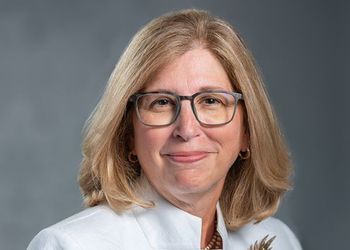Feature: Stemming The Tide: MSU’s Solution To The Stem Education Crisis

How many STEM graduates will it take to invent the next light bulb—or engineer better medicines and medical technologies, or develop new tools and resources for providing access to clean water or for restoring and improving our aging infrastructure?
Within the next decade, American businesses will require a million additional graduates with degrees in science, technology, engineering and mathematics degrees— collectively known as the STEM disciplines—in order to remain competitive internationally, according to the President’s Council of Advisors on Science and Technology (PCAST).
Yet, many American students are not performing as well as needed in these fields, according to R. James Kirkpatrick, dean of MSU’s College of Natural Science.
Results from recent international assessments of the science and mathematics achievements of fourth- and eighth-grade students in more than 50 countries found that U.S. students ranked seventh In fourth-grade science and tenth in eighth-grade science, with Singapore and Taiwan leading the rankings. In math, only 7 percent of U.S. students reached the advanced level in eighth-grade math, compared with 48 percent of eighth-graders in Singapore and 47 percent of eighth-graders in South Korea.
“At the university level, there are significant concerns that the United States is losing its leadership position in science and technology education as the demand for employees with strong STEM backgrounds continues to increase,” Kirkpatrick says. “Providing new levels of STEM education for today’s students is crucial to meet the changing needs of students and ensure their success in these critically important fields.”
This is not a new problem, according to Glenda Lappan, MSU Distinguished Professor of Mathematics. As early as 1975, Lappan and two of her colleagues in the mathematics department felt that middle school mathematics teaching materials were “woefully inadequate at capturing the imagination of students.”
“Elementary school students were not learning a lot about mathematics,” Lappan explains. “Unfortunately, students were not learning a lot about mathematics in middle school, either. Consequently, they were not well prepared for entering high school. And about 28 percent of incoming MSU freshmen were being placed into a remedial algebra course.
Improving the STEM Education Equation
“We felt that if we could do something that would improve students’ learning of mathematics, then our university and other universities across the United States would benefit,” says Lappan (see sidebar on p. 33).
In the early 1980s, she and colleagues Elizabeth Phillips and the late William Fitzgerald began to visit middle school classes in Michigan.
“We wanted to see if we could design more interesting ways to engage students in learning mathematics,” Lappan says. “We found that classroom discussions were focused on teachers telling students what they should see in The mathematics. Classes were arranged to promote students staying in their seats and thinking alone about how to follow mathematical procedures. We felt a great need to help students learn and enjoy what they were learning.”
With funding from the National Science Foundation (NSF), Lappan and her colleagues created five units, each of which focused on an important mathematical idea. In each unit, the mathematics was embedded in a sequence of problems that promoted deeper understanding and engagement with mathematics.
“They were an instant hit,” Lappan says. “Teachers began telling us: ‘You got us hooked with these five units. You can’t open the door to something that makes this kind of difference and not do more.’”
Those five units—originally referred to as the Middle Grades Mathematics Project (MGMP)— segued into the Connected Mathematics Project (CMP). CMP is a complete middle school mathematics curriculum, co-authored by Lappan, Phillips and Fitzgerald, along with James Fey from the University of Maryland and Susan Friel from the University of North Carolina. Development of the curriculum, supported by a $5 million NSF grant, began in 1991 and took six years to complete. The second iteration of CMP was also funded by a $4.5 million NSF grant.
“NSF felt the same as we did,” says Lappan. “If we didn’t do something about middle school math, we were never going to get high school graduates into STEM fields in college.”
A recent report by the President’s Council of Advisors on Science and Technology (PCAST) found that fewer than 40 percent of students who enter college intending to major in a STEM field actually complete a STEM degree.
“To test our early CMP materials, we engaged with a large group of teachers in summer institutes to help them understand what we were trying to accomplish,” Lappan explains. “Then we gave them the materials to use. The teachers who had been at these summer institutes were armed and ready to use what became the first iteration of Connected Mathematics.”
Both iterations of CMP were extensively field-tested over several years in diverse classrooms around the nation.
“Our idea was that we would give teachers a core curriculum that would serve all students, including students who were ready and able to push further,” she continues. “This approach worked extremely well in the first two iterations—so well that it has become a standard element of future CMP materials.”
Each year for the past 19 years, approximately 275 teachers and leaders have attended the weeklong Getting to Know CMP summer workshops and about 250 have attended the two-day annual February CMP Users’ Conference on campus.
“In both settings, the participants engage in intensive work in mathematics and pedagogy,” Lappan notes.
In August 2013, Callie Heck (B.A. mathematics ’04; M.A. curriculum and teaching ’08), a teacher at Holt Junior High in Holt, Mich., attended one such course. Heck has used CMP in her classroom for the past three years.
“The big difference I see is that students are doing the math in the classrooms,” Heck says. “They are engaging in the problems, figuring things out, coming up with strategies.”
For the unit on negative numbers, for example, CMP devised a system using red and black chips that relate to profit and loss. This provides a physical model, allowing students to figure out the properties of positive and negative numbers when they are added, subtracted and multiplied. Within the probability unit, spinner games and marble games are used as ways to look at experimental versus theoretical probabilities.
“With other textbooks I’ve used, the students were more recipients of the math, they were expected to absorb and reproduce— as opposed to generate or Think through,” Heck says. “And CMP makes me think more!”
Heck adds that typically, on a weekly basis, one of her students thinks of a new way to do a problem.
“In a traditional curriculum the student would never get the chance to do that,” she notes. “This validates the student and allows for students to drive the course of the class, or at the very least the discussions that the teacher has, unlike most other classrooms.”
“It has been a great joy to see students across the nation learning from these materials,” Lappan says. “As students have learned, so have teachers across the United States, as well as many in other countries.”
Today, approximately 30 percent of all middle schools in the United States use the curriculum.
“I think we’ve made a difference,” Lappan says. “We’ve seen mathematics scores go up in many districts that are using our curriculum materials.”
Money generated from the first and second iterations of the CMP textbook helped fund the third iteration, which was published this fall.
“We are grateful to the National Science Foundation for their support for the first two iterations of CMP and to Michigan State University and the University of Maryland for their support for iteration three,” Lappan says.
Connected Mathematics Project – Third Edition (CMP3)
For nearly 20 years, middle school students have been connecting with math in a unique way, thanks to CMP materials. There has been a startling transformation in the way middle school mathematics is taught today.
“We just finished the third iteration of the curriculum— CMP3—which is focused on making the curriculum materials even better, as well as aligning with the Common Core State Standards,” Lappan says.
CMP3 also takes advantage of the latest technologies, giving teachers even better ways of using CMP in their classrooms.
“This iteration of CMP has helped us to enter the digital age,” Lappan says. “Teachers will have devices to capture classroom engagement and to make notes that will help in planning. Being able to capture moments that a teacher wants to revisit with students is powerful for planning lessons and for helping a teacher track student progress. Students are much less likely to be ‘lost’ in a classroom now that teachers and students have better ways of communicating.
“As the cohort of teachers across the nation becomes even more aware of the usefulness of digital devices, the better the opportunities students will have to learn,” Lappan continues. “However, we cannot expect this to happen overnight. Teachers themselves need time and opportunities to work with each other and with consultants who can help them learn together and use technology in meaningful ways to promote student learning.
“Some worry that technology in the classroom may become a distracter, a tool that students can use to create interesting scenarios that promote little mathematical learning,” she adds. “To avoid this, teachers set norms in their classrooms that guide students in using technology for learning mathematics rather than primarily for play. However, we must consider ‘playing’ that involves mathematical ideas is a great motivation for learning mathematics!”
MSU—A Venue for First- Rate STEM Education
Partnering with the College of Education and Lyman Briggs College, the College of Natural Science aims to make MSU a venue for first-rate STEM education. They continue to develop new programs and approaches to meet the changing needs of students, including the Program in Mathematics Education (PRIME); The Institute for Collaborative Research for Educational Assessment and Teaching Environments (CREATE for STEM); an annual MSU Women in STEM conference; and Foundations of Science: A Massively Open Online Course (MOOC), which is now available worldwide (see sidebar on p. 34).
The staying power of the ideas that Fitzgerald, Phillips and Lappan generated and tried out in classrooms three decades ago is astonishing. Unfortunately, Fitzgerald died in 1998 and was not able to celebrate the longevity of the materials. In 2002, the Lappan-Phillips-Fitzgerald (LPF) Endowed Chair in Mathematics Education was created using royalties from CMP in honor of CMP’s three founders. The Lappan-Phillips Professorship of Science Education (see sidebar) was also made possible by royalty proceeds donated to MSU.
After nearly 50 years at MSU, Lappan will retire this spring.
“I’ve had a remarkable career,” Lappan says. “To say this has been a Labor of love is an understatement.”
She believes that CMP will be in good hands after her departure.
“It takes people who understand teachers, who are willing to get engaged with teachers so that, as you build the curriculum, you build the set of people who are going to be using this curriculum and talking about the curriculum,” Lappan says. “You need to be in touch with what is new in the terrain and then discern what you need to do to connect it to mathematics.
“CMP is a brand in the nation,” she notes. “In order for that brand to continue, we have to have people involved who understand the great care that has gone into creating materials that raise the ante for kids and for teachers. We’re trying our best to leave a legacy that can continue.”
“Enhancing overall student learning in the STEM fields is at the core of our college and Michigan State,” Kirkpatrick says. “MSU graduates have great impact around the world. We will continue to ensure that future alumni have the education they need to compete for jobs and to lead the nation in maintaining and building its competitiveness and leadership.”
Laura Seeley, ’80, is president of Classic Writing & Editing Services, LLC in Haslett. Val Osowski, ’81, MA ’86, is communications director of the MSU College of Natural Science.
KEY STEM PROGRAMS
in the College of Natural Science
The Connected Mathematics Program - An initiative created to improve the level of mathematics ability of K-12 students with a focus on the middle school years has profoundly changed the way that mathematics is taught in the U.S. Today, approximately 30 percent of all middle schools in the country use the Connected Mathematics textbook. The third edition (CMP3), designed to meet the new national Common Core State Standards in mathematics, has just been published.
Program in Mathematics Education (PRIME) - Provides scholars, teachers and students with a deep understanding of the teaching and learning of mathematics. Also, home to the Mathematics Education Graduate Program. It supports activities including the Lappan-Phillips-Fitzgerald Mathematics Education Colloquium Series, a mathematics learning research group, and a summer course for middle school mathematics.
The Institute for Collaborative Research for Educational Assessment and Teaching Environments (CREATE for STEM) - An interdisciplinary research institute focused on K-12 and university mathematics and science education. Sponsored by the Colleges of Natural Science and of Education, it aims to improve teaching and learning in the STEM disciplines through research and professional development efforts.
MSU Women in STEM conference - An annual conference geared toward early to mid-career alumnae. Participants connect with other MSU alumni in STEM professions, expand their professional networks, and acquire tools and knowledge that can assist them in furthering their career objectives.
Foundations of Science: A Massively Open Online Course (MOOC) - Online instruction courses in the STEM disciplines reach large numbers of people at a relatively low cost. This MOOC is available worldwide.
Center for Integrative Studies in General Science (CISGS) - Provides students who are not majoring in science, mathematics, or engineering with an understanding of major concepts in the biological and physical sciences.
LAPPAN-PHILLIPS PROFESSORSHIP
of Science Education
Royalties from the Connected Mathematics 2 textbook, the single most widely used mathematics textbook in America for students in grades 6-8, have been donated by Glenda Lappan and Elizabeth Phillips to MSU to create the Connected Mathematics Project 2 (CMP2) Fund.
This has made possible the Lappan-Phillips Professorship of Science Education, among other things.
Last spring, Melanie M. Cooper, an Alumni Distinguished Professor of Chemistry at Clemson University, was named the first Lappan-Phillips Professor of Science Education in the MSU Dept. of Chemistry.
“These Connected Math funds are an extraordinary and special resource for MSU,” says Kirkpatrick, dean of MSU’s College of Natural Sciences. “I know of no other university that has these kinds of resources to spend on math and science education. This professorship is a perfect example of how we can leverage these funds to improve the education of our own students, education at the K-12 level and research on STEM education within disciplines. We are most grateful to Glenda and Betty for helping to make this professorship possible.”
Cooper says the professorship will serve to advance her work and provide a significant boost to the discipline-based education research (DBER) field.
Other areas that CMP funds are helping include: Operational support for PRIME (Program in Mathematics Education) Graduate Program; the Create-4-STEM Institute (jointly sponsored by the Colleges of Natural Science and Education) 1825 Project, “Developing Mathematical Proficiency for Success in Undergraduate Education and STEM Disciplines;” start-ups for several faculty members in STEM education; seed money for research projects in STEM education; and the Lappan-Phillips-Fitzgerald Lecture Series and Mathematics colloquium.
GLENDA LAPPAN
University Distinguished Professor of Mathematics
Glenda Lappan has come a long way—from farm girl in southern Georgia to MSU Distinguished Professor of Mathematics. Due to her perseverance, and her dedication as a mathematics teacher and researcher, there has been a startling transformation in the way middle school mathematics is taught today.
Lappan, an only child, grew up in a family that didn’t have a lot of financial resources. Whenever she was asked about going to college, she’d respond: “I know that we don’t have money, but I have a plan. I’m going to work really hard, I’m going to save my money, and some day I’m going to get to go to college.”
And she did. She was awarded a full scholarship and earned her bachelor’s degree from Mercer University in 1961. She taught high school mathematics in Douglas, GA, and then earned her master’s and doctoral degrees from the University of Georgia in 1963 and 1965, respectively.
Lappan joined MSU as an assistant mathematics professor in 1965. After teaching mathematics and mathematics education for 10 years, she turned her attention to mathematics curriculum research.
With colleagues Elizabeth Phillips and the late William Fitzgerald, Lappan developed the Connected Mathematics Project (CMP), a curriculum now used by approximately 30 percent of all middle schools in the United States. The third edition of the curriculum— CMP3—was published in fall 2013.
In 1998, Lappan was designated University Distinguished Professor in recognition of the importance of her work. In 2002, the Lappan-Phillips-Fitzgerald Endowed Chair in Mathematics Education was created in honor of CMP’s three founders.
Lappan will retire this spring after 50 years at MSU. She plans to spend time traveling with her husband.



